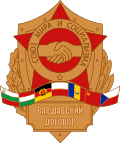
Back Wit-Russiese Sosialistiese Sowjetrepubliek Afrikaans Republica Socialista Sovietica de Belarrusia AN جمهورية بيلاروس الاشتراكية السوفيتية Arabic República Socialista Soviética de Bielorrusia AST Belorusiya Sovet Sosialist Respublikası Azerbaijani بلاروس شوروی سوسیالیست جومهوریتی AZB Белорус Совет Социалистик Республикаһы Bashkir Беларуская Савецкая Сацыялістычная Рэспубліка Byelorussian Беларуская Савецкая Сацыялістычная Рэспубліка BE-X-OLD Белоруска съветска социалистическа република Bulgarian
Byelorussian Soviet Socialist Republic[a] Беларуская Савецкая Сацыялістычная Рэспубліка (Belarusian) Белорусская Советская Социалистическая Республика (Russian) | |||||||||||||||||
|---|---|---|---|---|---|---|---|---|---|---|---|---|---|---|---|---|---|
| 1920–1991 1941–1944: German occupation | |||||||||||||||||
Flag
(1951–1991) State emblem
(1981–1991) | |||||||||||||||||
| Motto: Пралетарыі ўсіх краін, яднайцеся! (Belarusian) Pralyetaryi wsikh krain, yadnaytsyesya! (transliteration) "Workers of the world, unite!" | |||||||||||||||||
| Anthem: Дзяржаўны гімн Беларускай Савецкай Сацыялiстычнай Рэспублiкi Dzyarzhawny himn Byelaruskay Savyetskay Satsyyalistychnay Respubliki "Anthem of the Byelorussian Soviet Socialist Republic" (1955–1991) | |||||||||||||||||
 Location of Byelorussia (red) within the Soviet Union (red and white) between 1956 and 1991 | |||||||||||||||||
| Status | 1920–1922: Nominally independent state 1922–1990: Union Republic 1990–1991: Union Republic with priority of Byelorussian legislation | ||||||||||||||||
| Capital | Smolensk (1—6 January 1919), Minsk (since 7 January 1919) | ||||||||||||||||
| Official languages | |||||||||||||||||
| Recognised languages | |||||||||||||||||
| Religion | State atheism | ||||||||||||||||
| Demonym(s) | Byelorussian, Soviet | ||||||||||||||||
| Government |
| ||||||||||||||||
| First Secretary | |||||||||||||||||
• 1920–1923 (first) | Vilgelm Knorin | ||||||||||||||||
• 1988–1990 (last)[2] | Yefrem Sokolov | ||||||||||||||||
| Head of state | |||||||||||||||||
• 1920–1937 (first) | Alexander Chervyakov | ||||||||||||||||
• 1991 (last) | Stanislav Shushkevich | ||||||||||||||||
| Head of government | |||||||||||||||||
• 1920–1924 (first) | Alexander Chervyakov | ||||||||||||||||
• 1990–1991 (last) | Vyacheslav Kebich | ||||||||||||||||
| Legislature | Congress of Soviets (1920–1938) Supreme Soviet (1938–1991) | ||||||||||||||||
| History | |||||||||||||||||
• First Soviet republic declared | 1 January 1919 | ||||||||||||||||
• Second Soviet republic proclaimed | 31 July 1920 | ||||||||||||||||
| 30 December 1922 | |||||||||||||||||
| 15 November 1939 | |||||||||||||||||
| 24 October 1945 | |||||||||||||||||
• Sovereignty declared, partial cancellation of the Soviet form of government | 27 July 1990 | ||||||||||||||||
• Independence declared | 25 August 1991 | ||||||||||||||||
• Renamed Republic of Belarus | 19 September 1991 | ||||||||||||||||
| 10 December 1991 | |||||||||||||||||
• Internationally recognized (dissolution of the Soviet Union) | 26 December 1991 | ||||||||||||||||
| Area | |||||||||||||||||
• Total | 207,600 km2 (80,200 sq mi) | ||||||||||||||||
| Population | |||||||||||||||||
| 10,199,709 | |||||||||||||||||
| Currency | Soviet rouble (Rbl) (SUR) | ||||||||||||||||
| Calling code | +7 015/016/017/02 | ||||||||||||||||
| |||||||||||||||||
| Today part of | Belarus Lithuania[c] Poland Russia | ||||||||||||||||
| History of Belarus |
|---|
| Prehistory |
| Middle ages |
| Early Modern |
|
| Modern |
|
|
|
| Eastern Bloc |
|---|
 |
The Byelorussian Soviet Socialist Republic[d] (BSSR or Byelorussian SSR;[e] Belarusian: Беларуская Савецкая Сацыялістычная Рэспубліка;[f] Russian: Белорусская Советская Социалистическая Республика),[g] also known as Byelorussia,[h] was a republic of the Soviet Union (USSR). It existed between 1920 and 1991 as one of fifteen constituent republics of the USSR, with its own legislation from 1990 to 1991. The republic was ruled by the Communist Party of Byelorussia.[3] Other names included White Russia or White Russian Soviet Socialist Republic.[4]
Following the Treaty of Brest-Litovsk in March 1918, which ended Russia's involvement in World War I, the Belarusian Democratic Republic (BDR) was proclaimed under German occupation; however, as German troops left, the Socialist Soviet Republic of Byelorussia was established in its place by the Bolsheviks in December, and it was later merged with the Lithuanian Soviet Socialist Republic in 1919 to form the Lithuanian–Byelorussian Soviet Socialist Republic, which ceased to exist as a result of the Polish occupation during the Polish–Soviet War. Following a peace treaty with Lithuania, the Socialist Soviet Republic of Byelorussia was re-founded on 31 July 1920 and later became known as the Byelorussian Soviet Socialist Republic.
The BSSR became one of the four founding members of the Soviet Union in December 1922, together with the republics of Russia, Transcaucasia, and Ukraine. Byelorussia was one of several Soviet republics occupied by Nazi Germany during World War II. Towards the final years of the Soviet Union's existence, the Supreme Soviet of the Byelorussian SSR adopted the Declaration of State Sovereignty in 1990. On 25 August 1991, the Byelorussian SSR declared independence, and on 19 September it was renamed the Republic of Belarus. The Soviet Union was formally dissolved on 26 December 1991.
Cite error: There are <ref group=lower-alpha> tags or {{efn}} templates on this page, but the references will not show without a {{reflist|group=lower-alpha}} template or {{notelist}} template (see the help page).
- ^ Кожинова, Алла Андреевна (2017). "Языки и графические системы Беларуси в период от Октябрьской революции до Второй мировой войны". Studi Slavistici. 14: 133–156. doi:10.13128/Studi_Slavis-21942.
- ^ 28 July 1990 from Art. 6 of the Constitution of the Byelorussian SSR, the provision on the monopoly of the Communist Party of Byelorussia on power was excluded
- ^ L. N. Drobaŭ (1971). Art of Soviet Byelorussia. Avrora.
- ^ Webster's (1978). Webster's Encyclopedia of Dictionaries New American Edition. Webster's.
© MMXXIII Rich X Search. We shall prevail. All rights reserved. Rich X Search

